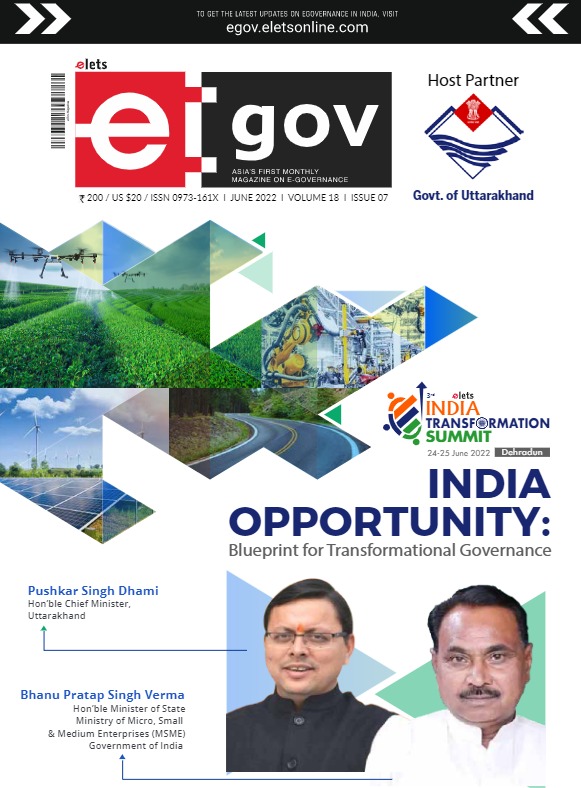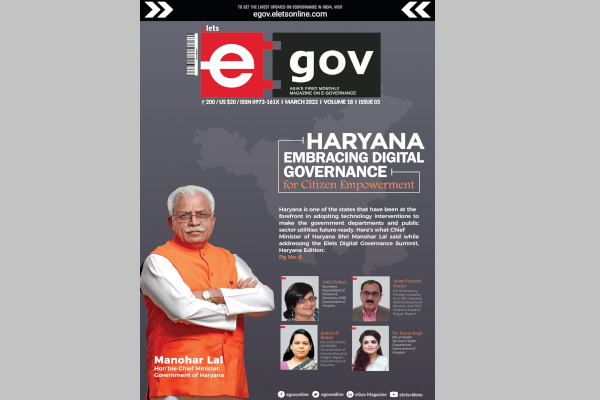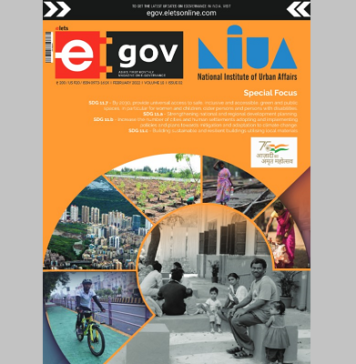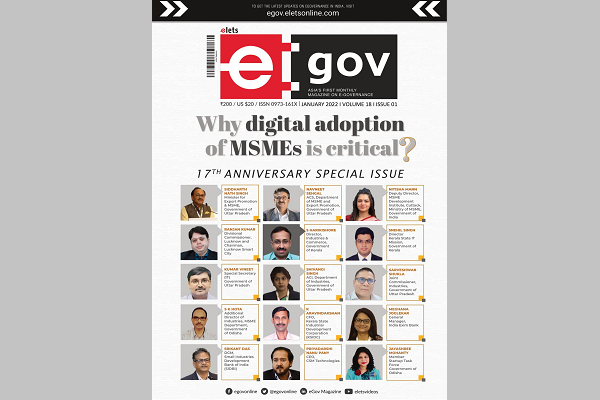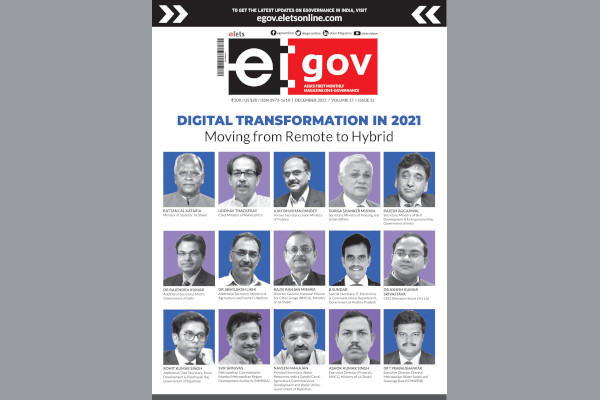
It is a leap of faith that has catapulted Haryana as one of the most digitally empowered States. Known till sometime back as an agrarian State, Haryana is now leading the country in digital payments transactions on per capita basis. The State has become the most fertile ground for young minds brainstorming innovations. The highest number of start-ups have been registered here across the country, writes Priya Yadav of Elets News Network (ENN).
 Consider this, Haryana records 11.43 digital payments transactions on per capita basis which is the third highest in the country and way ahead of other States. Chandigarh tops the charts with 36 digital payments transactions followed by Andhra Pradesh which boasts of 16 on per capita basis.
Consider this, Haryana records 11.43 digital payments transactions on per capita basis which is the third highest in the country and way ahead of other States. Chandigarh tops the charts with 36 digital payments transactions followed by Andhra Pradesh which boasts of 16 on per capita basis.
From being the food bowl of the country, Haryana is now the economic powerhouse of the nation. The State registered 15 percent averaged Gross State Domestic Product (GSDP) growth rate in the last decade and with 1.3 percent of country’s total area contributes nearly 4 percent to India’s Gross Domestic Product (GDP). It is among five states of the country which cumulatively hosts more than 90 percent foreign firms and tops the States in terms of Ease of Doing Business.

There is a spectrum of opportunities for young entrepreneurs in Haryana and Gurugram, which is now the face of the state and financial capital in its own right, has the highest concentration, 5 percent of total world’s BPO workforce.
The Hartron Innovation Campus in Gurugram has emerged as a beacon of hope for all the budding entrepreneurs. The Government of Haryana has managed to create a conducive environment for Startups in the State, by taking key initiatives regarding incubation support. The creation of this incubation network is an analogue to a Hub and Spoke Model; the Startup Warehouse already operating in Gurugram, in collaboration with NASSCOM, has been nominated as the Hub incubator, while the UN Technology Innovation Lab (UNTIL), Mobile Application Development Centre (IAMAI), Center of Excellence (IoT Lab) and the Startup Incubator at Panchkula act as Spokes.

The UN Technology Innovation Lab (UNTIL) at the Hartron Innovation Campus in Gurugram offers support to budding entrepreneurs. The facilities include a process to increase collaboration and pooling of research results. It is a means to develop better understanding of the local and regional innovation systems in their respective parts of the country and is a network to systematically compare research findings across cities and regions.
- It encourages women entrepreneurship and fund raising for women technology startups
- It facilitates international partnerships and helps bring in and apply best practices in Haryana
- Targeting inclusion in the UN support for Global ID 2020 Programme.
- Haryana has the distinction of being the first State in the country to be part of this programme.
The Mobile Application Development Centre (IAMAI) at the Hartron Campus is another incubator which offers support to budding entrepreneurs including mentor support, subsidised incubation Infrastructure that have
- Approximately 75 seats
- Testing and design centres
- Space for training programmes and hackathons
- Power backup, internet lines, vibrant interiors
- Conference hall with AV
- Meeting rooms
- Cafeteria, and
- Housekeeping facilities.
 The Centre of Excellence (IoT Lab) which has come up recently is a feather in the cap and offers support to budding entrepreneurs: promoting the innovators capabilities by mentoring
The Centre of Excellence (IoT Lab) which has come up recently is a feather in the cap and offers support to budding entrepreneurs: promoting the innovators capabilities by mentoring
- Competencies in specialised technologies
- Undertaking business and academic research activities through partnerships with academic and research partners
- Providing access to an economic technology driven virtual environment with requisite tools to validate experimentation
- Creating/developing a library/stack of reusable solutions
- Assistance on developing skill sets
- Enable networking between Industry, Academia, Entrepreneurs and Government.
Another incubator, the NASSCOM Warehouse, offers support to budding entrepreneurs including:
- Mentor support
- Subsidised incubation Infrastructure
- Plug and play services
- Workshops and startup events
- Shared co-working spaces to be shared with fellow entrepreneurs
- Approximately 84 seats
- 100 percent power backup, leased internet line, agile and vibrant interiors
- Conference rooms and lecture theatres.
In Haryana, the State government has rewritten the meaning of governance and made it good governance by making the administration a two-way traffic. It reaches out to the people and facilitates them to revert with their suggestions and views which are duly factored in while taking the final call on policies and programmes. So much so, draft policies are thrown in public domain to elicit views and suggestions. The difference this has made is more than mirrored by the change brought about in the way the administration thinks, feels and acts to address people’s needs, and answer their aspirations. I take pride in sharing with you all that this approach has made the people of Haryana feel the change.
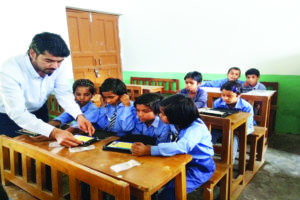 Innovative and out-of-the-box thinking continues to characterise the functioning of the State government. The systems laid and methods of delivery evolved have made the man in the street, be it farmer, trader, service provider, or one running business or industry, feel assured of the kind of governance he or she craves for.
Innovative and out-of-the-box thinking continues to characterise the functioning of the State government. The systems laid and methods of delivery evolved have made the man in the street, be it farmer, trader, service provider, or one running business or industry, feel assured of the kind of governance he or she craves for.
Living up to its avowed objective of being always in the service of the people, the State Government has made conscious and concerted efforts to ensure that the wide range of services offered to the people are not only fast-tracked and made time-bound and hassle-free, but are also rid the twin menace of nepotism and graft.
Also Read: Hartron: Implementing Digital India vision in Haryana
Committed to delivering services to the people in a transparent, time-bound and hassle-free manner through an effective service delivery mechanism, the State has implemented the Haryana Right to Service Act, 2014. It was enacted with the sole objective of providing an effective framework for time-bound delivery of services provided by various government departments in order to promote transparency and accountability. Services thus delivered enhance the credibility of the Government.
Further, Haryana has taken the e-route to speed up service delivery, beat graft and nepotism. A large number of initiatives have been taken to usher in an era of e-governance. Sustained efforts have been made at multiple levels to improve the delivery of public services and simplify the process of accessing them. E-governance in the State has steadily evolved from computerisation of government departments to initiatives that encapsulate the finer points of governance, such as citizen centricity, service orientation and transparency.
The State has taken giant strides in provision of IT infrastructure, e-governance, providing services on demand and digital empowerment of citizens.
To strengthen wired and wireless infrastructure, the State has laid optical fibre reaching 5,620 villages under National Optic Fibre Network programme now known as Bharatnet. This network shall ensure provision of 100 mbps internet connectivity to all Gram Panchayats. Haryana has notified a Communications and Connectivity policy that seeks to ensure quality infrastructure for connectivity & telecommunication services and bridge the gaps in telecom connectivity (both wired and wireless) across Haryana.
With a vision to convert the State into a digitally empowered society and knowledge economy and to improve the quality of service delivery, State is offering e-governance services which exhibit following three key tenets i.e. cashless, paperless and faceless. The endeavour is to provide to a beneficiary the option of electronic/digital payment modes, no physical paper at any level for rendering of service and ensuring that beneficiary is not required to come in contact with government personnel, unless it’s a legal requirement.
In the recent past, Haryana has taken various landmark initiatives for improving access to digital infrastructure, increased digital delivery of services and empowerment of the citizens.
The State has undertaken many e-governance projects like CM Window, e-Bhoomi, e-Registration, e-Payment, e-Filling, e-Tendering, e-Refund, e-Disha, E-Tourism, e-Ticketing etc.
CM Window Haryana is a public grievances redressal and monitoring system launched to show transparency in governance and ensure immediate redressal of people’s grievances. It has been designed to meet the twin objectives of minimum administration and maximum governance. Till date, about 2.4 lakh complaints have been successfully addressed.
It has launched e-Bhoomi for sale of land directly to government. Similarly, e-Services for traders such as e-Registration, e-Payment, e-Filling, e-Tendering, e-Refund etc, are available at www.haryanatax.gov.in.
Besides, Integrated Financial Management System (IFMS) has been implemented for online communication, release, allocation, revision, re-appropriation of budget by the Finance Department. The budget preparation now takes only two months as compared to eight months earlier which exemplifies responsive and responsible governance.
The State Government has also approved setting up of 20 District Level eDisha Centres (DLeDC), one each at district headquarters. e-District Haryana (e-Disha) is an IT-driven electronic interface between the government and the citizens that facilitates the general public to receive effective and timely services.
The Haryana Tourism Corporation, a pioneer in highway tourism which operates 42 tourist complexes, too has taken the e-route to boost tourism. A web portal as per the W3C guidelines integrated with Online Rooms Booking System and Online e-Ticketing for Surajkund International Crafts Mela has been developed to exploit the full potential of tourism in the State.
As a part of the nationwide 100-day special campaign to promote digital and cashless transactions, ‘Digi DhanMelas’ were organised in the State. During 2016-17, 91.12 percent of government payments amounting to 5,4415.91 crore were done electronically by our State treasuries.
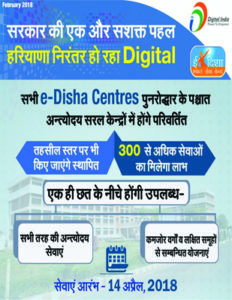 Haryana has achieved 100 percent Aadhaar saturation in the 0 to 5 Years Age category. Haryana tops the list with 71.6 percent Aadhaar coverage, while the national average is only 38.8 percent in this category.
Haryana has achieved 100 percent Aadhaar saturation in the 0 to 5 Years Age category. Haryana tops the list with 71.6 percent Aadhaar coverage, while the national average is only 38.8 percent in this category.
An end-to-end computerisation of Targeted Public Distribution System has been implemented across the State covering Online Ration Cards Management, Allocation, Supply Chain Management, Ration distribution through Point of Sale devices at FPS using Aadhaar based authentication using both Cash and Cashless (successfully carried out in Ambala on pilot basis) modes. This system caters to more than 1.3 crore beneficiaries. Due to digitisation of beneficiaries, Haryana has become Kerosene Free.
Keeping pace with the national efforts, VAHAN and Sarthi, the e-governance applications under National Transport Project, been successfully implemented in all 94 RLA and RTA offices.
The Online Drug Inventory and Supply Chain Management System (ODISCM) integrates various inter-related activities of the National Rural Health Mission (NRHM), Haryana for improving efficiency and effectiveness of Procurement system and Distribution System, which ensures streamlining the distribution of drugs to institutions and ensures availability of drugs at all times, strengthening the system of Quality Controls, over drugs procurement and distribution according to the new drug policy of Government of Haryana.
Digital empowerment of citizens is equally important to harness their full potential in an increasingly digital environment. Digital literacy is also vital for the people to avail e-services. Conscious of this reality, State Government aims to make at least one member of each family digitally literate so that all families can access public e-services. The target is to cover 12 lakh households during the current year. We will achieve this goal by leveraging the Atal Seva Kendras, the State Skill University, the Saksham Yuva (unemployed Graduates & post Graduates) and by involving the Education Department. Already registered four lakh households under the Digital Literacy Programme, and about two lakh persons have been made digitally literate.
To bring government services to the doorstep of citizens, we have set up 5,500 Atal Seva Kendras out of which 4,000 are located in villages. This has made the process of obtaining citizen services simple and convenient for both citizens and state departments. A village-level entrepreneur (VLE) is selected as Atal Seva Kendra operator-cum-manager and is authorised to act as a citizen delivery point. We intend to cover all Gram Panchayats (6205) by 2018. Currently, our 4,000 rural ASK Centres have conducted 36.5 lakh transactions from May, 2015 till date. We are also shifting the ASK VLE to the village level mini-secretariats i.e. Gram Sachivalayas. About 100 ASKs are now operating from the Gram Sachivalayas in the villages.
We believe in pro-active governance, where, instead of citizen coming to government to seek a service, we shall deliver services proactively at the citizen’s doorstep. For example, when a child is born he or she is tracked for the services required as he or she grows, such as birth certificate, vaccination required, health and nutrition, admission in schools and so on.
To attract investors to Haryana, we have set up Single Roof Mechanism (Haryana Enterprise Promotion Portal i.e. https:// investharyana.in/#/). It was launched in February, 2017 and Haryana is the only State in India which went ahead of the Single Window concept and envisioned to have a Single Office for giving all industrial clearances/licenses. All industrial approvals are being given online in a time-bound manner thorough this portal and single office.
 In a short span of time, Haryana has received more than 1,500 applications on this portal which underscores the confidence of the investor community in us. It is no wonder that Haryana has been promoted from rank 14th to rank 6 in the span of two years on the ease of doing business ratings. In fact, we are rated as the best state for EoDB in North India.
In a short span of time, Haryana has received more than 1,500 applications on this portal which underscores the confidence of the investor community in us. It is no wonder that Haryana has been promoted from rank 14th to rank 6 in the span of two years on the ease of doing business ratings. In fact, we are rated as the best state for EoDB in North India.
An example of collaborative governance is the mobile application “HARPATH” which uses GIS technology to help us make our roads infrastructure safer and smoother. This app enables the citizens to convey to the government the road conditions on real time basis for immediate action to restore and repair road infrastructure or traffic bottlenecks. If citizen feedback is not acted upon within a certain time-frame, there is a built-in escalation matrix to ensure that responsibility is fixed and we deliver on time.
Haryana is the first State to implement :
- Dynamically Integrated Property Registration and Land Records Systems
- In house developed e-Stamping solution integrated with property registration
- End-to-end e-PDS solution in State in 100 percent shops and second state to introduce Aadhaar enabled cashless transactions
- 0 in all registering authorities & SARTHI 4.0 in all RLA authorities
- Integrated Online paperless Entrance Exam & On-Line Off-Campus Counselling Systems
- Aadhaar Based Birth Registration; AEBAS for all state government employees
- Jeevan Praman Patra integrated with e-Pension Portal
- Pilot of Paperless Bill Submission in treasury
- e-GRAS Integration with GST, CSC-SPV e-Wallet & POS machines
- E-Registration
- Shifting employees Loans to Banks
- Integration of School Board certificates with Digi-Locker etc.
Be a part of Elets Collaborative Initiatives. Join Us for Upcoming Events and explore business opportunities. Like us on Facebook , connect with us on LinkedIn and follow us on Twitter, Instagram.




